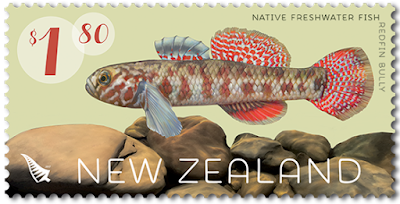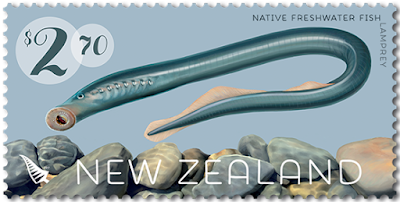More than 40 different species of freshwater fish have been identified in New Zealand’s waterways. Around three-quarters of these secretive and largely nocturnal natives are already endangered, which is a troublingly high number compared to other countries. Some of the issues our freshwater fish face include barriers in migration, destruction of habitat and the introduction of predators such as trout.
Many of New Zealand’s freshwater fish species have had to evolve unique attributes in order to live in our varied habitats. The lowland longjaw galaxias is so named for its distinctive upturned lower jaw, the redfin bully has taught itself to climb, the longfin eel can live for up to 100 years, the lamprey is commonly known as a “vampire parasite” and the torrentfish has a unique zebra-style camouflage.
From deep ice-cold lakes to fast moving raging rapids, the vast range of species found in New Zealand’s waterways are celebrated with these beautifully illustrated stamps. The diversity of New Zealand’s aquatic life is clearly apparent when these stamps are viewed side by side.
The Stamps.
$1.00 - Lowland Longjaw Galaxias.
With its thin, elongated body and small fins, the glittery lowland longjaw is one of the ‘pencil’ galaxias. This shape allows them to burrow into the gravel to lay eggs, feed and to survive during flooding or low flows. They are named after their distinctive upturned lower jaw. Found only in the Kauru and Kakanui Rivers, and a handful of streams in the upper Waitaki catchment, this species is thought to have less than 250 mature adults, making it one of our rarest native fish species.
$1.80 - Redfin bully, Toitoi.
Bring on the colour circus! The redfin bully male has flashy red markings on his tail and fins compared to the duller brown female. He dutifully guards their eggs until they hatch, temporarily turning black for this role. You can spot a redfin bully by the diagonal stripes on the cheeks, similar to war paint. The redfin tends to live close to the coast in stony streams and these acrobatic climbers can be found above waterfalls. The young larvae of the species wash out to sea and return to freshwater as juveniles.
$2.20 - Longfin eel, Tuna.
This familiar favourite is only found in New Zealand, can live for over 100 years and grow into legendary two-metre giants. Sadly, eels of this size are becoming rarer, as concerns grow over the effects of commercial fishing, habitat destruction and damming. Tuna is of utmost significance to Māori and traditionally was an important food source. Found widespread around New Zealand, the young elvers are phenomenal climbers of waterfalls. The longfin must complete an epic migration to Tongan waters to breed right at the end of their life.
$2.70 - Lamprey, Kanakana, Piharau.
The lamprey is a primitive jawless fish, sometimes mistaken for an eel. It has a round mouth with rasping teeth and seven-gill pores among other distinctive features. Lamprey adults spend their lives at sea as ‘vampire parasites’ on other fish, then migrate to freshwater to breed. In fresh water, they change from a metallic blue to a dull brown, and the male develops a bizarre baggy pouch under the eyes. The species is found around the Southern Hemisphere.
$3.30 - Torrentfish, Panoko.
This riffle-surfer has adapted to fast-flowing water. In fast flows its strong pectoral fins anchor it to the riverbed and prevent it from washing away! The zebra-like camouflage colourings and its tendency to freeze when threatened make this a hard fish to spot. It moves into slower flows at night to feed. The torrentfish is endemic to New Zealand and typically widespread throughout. It resembles its more familiar marine relative, the blue cod.
Other Collector Items.
The First Day Cover for this issue.
The Miniature Sheet.
The Miniature Sheet on First Day Cover.
Native New Zealand Freshwater Fish Presentation Pack.
The presentation pack contains further information about New Zealand’s freshwater fish as well as the set of five stamps, the miniature sheet and first-day cover. It has been written by Sophie Allen, a freshwater ecologist with Working Waters Trust.
Native New Zealand Freshwater Fish Limited Edition.
The Limited Edition is the ultimate collector's item for this issue. Learn more with the booklet containing the plate blocks, which has been written by Stella McQueen, a freshwater fish specialist, science communicator and author of ‘The New Zealand Native Freshwater Aquarium’ and ‘A Photographic Guide to Freshwater Fishes of New Zealand’. There is a unique numbered imperforate miniature sheet and a limited edition first day cover signed by Stella McQueen, and as an added bonus this pack contains colour separations of the $3.30 stamp and the fish on each stamp has a special gloss coating. Expected ship date for the Limited Edition is 28 March 2017.
Set of five Plate Blocks.
Set of five Value Blocks.
Technical information
| Date of issue: |
1 March 2017
|
|---|---|
| Number of stamps: |
Five gummed stamps
|
| Denominations: |
$1.00, $1.80, $2.20, $2.70, $3.30
|
| Stamps designed by: |
Stephen Fuller, Wellington, New Zealand
|
| Printer and process: |
Southern Colour Print by offset lithography
|
| Number of colours: |
Four
|
| Stamp size and format: |
50mm x 35mm (horizontal)
|
| Paper type: |
Tullis Russell 104 gsm gummed stamp paper
|
| Number of stamps per sheet: |
25
|
| Perforation gauge: |
14.4 x 14
|
| Period of sale: |
Unless stocks are exhausted earlier, these stamps will remain on sale until 1 March 2018. First-day covers will remain on sale until 30 April 2017.
|
Stamps and information for this post came from.














We appreciate your engagement with our content. To ensure a respectful and constructive community, please take note of the following:
- No Spam, Please: We do not tolerate spammy or promotional comments. Any such comments will be promptly removed.
- Moderation in Place: All comments are moderated to maintain a positive and inclusive environment. Please be patient, as it may take a little time for your comment to appear.
- Sign In with Google: To comment, please sign in using your Google account. This helps us maintain the integrity of our community and allows for better interaction.